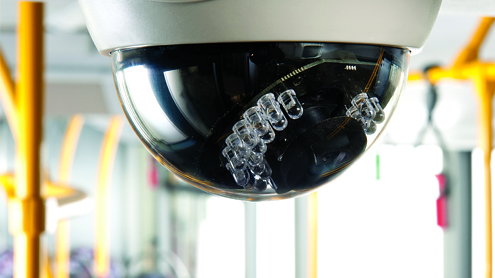
By Ryan Kelly
An effective security plan should include development of a comprehensive surveillance strategy.
In the advent of the recent Boston Marathon bombings, surveillance has once again proven to be a critical tool in recognizing suspicious behavior. In the bus transportation industry, surveillance is more typically used to observe facilities, vehicles, and people in and around the vehicles and passenger boarding areas. Surveillance is also a proactive tool to deter individuals from acting unsafely or illegally.
An effective security emergency preparedness plan should include development of a comprehensive surveillance strategy. The first step is to analyze the facility vulnerabilities and try to eradicate any issues that are weakening security.
A perimeter camera system to observe and record all activities around the bus yard is one means of preventing any vulnerability to company property
Advances in technology have reduced the costs of this technology dramatically, making it easier for bus companies to purchase camera surveillance systems.
Installation of cameras throughout the interior of a facility can help reduce fraudulent worker’s compensation activity and illegal behavior such as theft or inappropriate work activity. Interior surveillance also can be incorporated to also monitor employee and customer interactions, as well as package deliveries.
Onboard video surveillance assists in two critical areas. In the area of passenger safety, vehicle event recorders have proven to modify unsafe driving habits and help reduce accidents. These systems also assist a bus company in litigation by determining the actual factors that contributed to the cause of the accident when there is a difference of opinion. Event recording systems provide a safer environment by monitoring passenger behavior and recording unsafe or illegal activity taking place on the vehicle.
Secondly, onboard video surveillance aids in monitoring the efficient performance of buses such as staying on route, idling activity and fuel economy. As technology has progressed, many surveillance systems now offer electronic onboard recording (EOBR) for hours-of-service compliance. Many of these systems can be integrated to monitor drivetrain systems and assist with maintenance requirements.
Onboard video recording devices are available to assist with monitoring the safety and security of passengers and the driver during stops to load and unload riders. Cameras help because:
• Pedestrians are always near the bus as it approaches or leaves a stop.
• The driver is typically providing multiple services at one time, such as assisting passengers, loading and unloading luggage and monitoring the vehicle.
• Entrances to the bus may be unmonitored.
• The driver’s area is vulnerable.
• Open luggage doors may provide easy access.
• Engine and other access doors may become vulnerable, because the entire bus is likely open and unlocked.
Therefore, a quality surveillance system may help to deter unscrupulous activity or record activity that could compromise the safety and security of passengers. The onboard recording system can also be used as a teaching tool to mitigate unwanted security events while improving driver customer service.
The two types of vehicle surveillance systems are real-time and event recording. Real-time onboard surveillance systems provide a critical tool in mitigating and responding to events onboard buses by providing immediate information to first responders and company personnel. A motion detector that senses extremes in G Force momentum within the vehicle triggers event recorders. The driver can manually trigger both the event recorder and real-time surveillance system.
However, even the most expensive onboard surveillance system is worthless if no one monitors the information. There are countless examples of cases where unscrupulous activity was recorded, but the perpetrator got away because no one was monitoring the system. For surveillance systems to be effective, employees must understand the system and develop an appreciation for the technology. A cultural change must take place within company. It requires thorough employee education and top-down acceptance at all levels.
